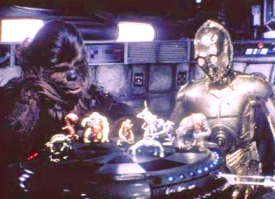Playing and interacting with a 3D image projected from your phone or other objects may not be totally out of reach after all.
 |
| A hologram created in Japan |
MasterImage 3D is best-known in Hollywood for its 3D projectors, but it is now developing a technology that seemed pretty impossible when Chewbacca played holographic chess with R2-D2, or when the projection of Leia pleaded to Obi Wan Kenobi. The new and as yet unnamed technology will allow a phone or a tablet like the iPad to project an image that you can interact with by merely touching it, like Star Trek's holodecks. Games using this tech are a no-brainer, but web-browsing and other daily tasks will also be possible. MasterImage 3D will debut the technology at Mobile World Congress from Feb. 14-17 in Barcelona.
 |
| Playing holographic chess |
"If you take the screen and lay it flat, it projects the holographic object around your device, and you can interact with it," said Roy Taylor from MasterImage.
He's made the tech available to software companies and they're already spinning their wheels on coming up with applications using 3D images. "Software companies are already working on productivity enhancements with touch," Taylor said. "This will be the evolution of how we interface with consumer-electronics devices."
At first glance, the tech seems to be little more than a trick. After all, you aren't really touching the holograms as they are composed of light and all, at least not as much as you are manipulating them by placing your hand in a certain place. In the case of a recent Japanese invention, the ball projection doesn't bounce off your palm, for example — the system registers that that's where your hand is and the virtual ball reacts accordingly.
 |
| Darth Maul hologram |
The only stumbling block for Roy Taylor's plan might be the lack of 3D capability for most phones, but he's working on a graphics chip that can provide the extra oomph without costing your first born's college education. "I think we can get a 3D phone down to around $150," he said.
$150 would mean an okay phone nowadays. A lot of high-tech phones stretch hundreds more. But a hologram projecting phone that I can interact with? For that price? I'm sold.
Plus, if you think about it, touching a 3D image to manipulate a game is even more advanced than Star Wars. Even R2 had to use his information plunger thing to play the game and when Luke touched the hologram of Leia she just disappeared. Next thing you know we'll come up with an engine that lets us make the Kessel run in less than 9 parsecs.
http://www.escapistmagazine.com/news/view/107713-3D-Holograms-Coming-to-Your-Phone-from-a-Galaxy-Far-Far-Away















